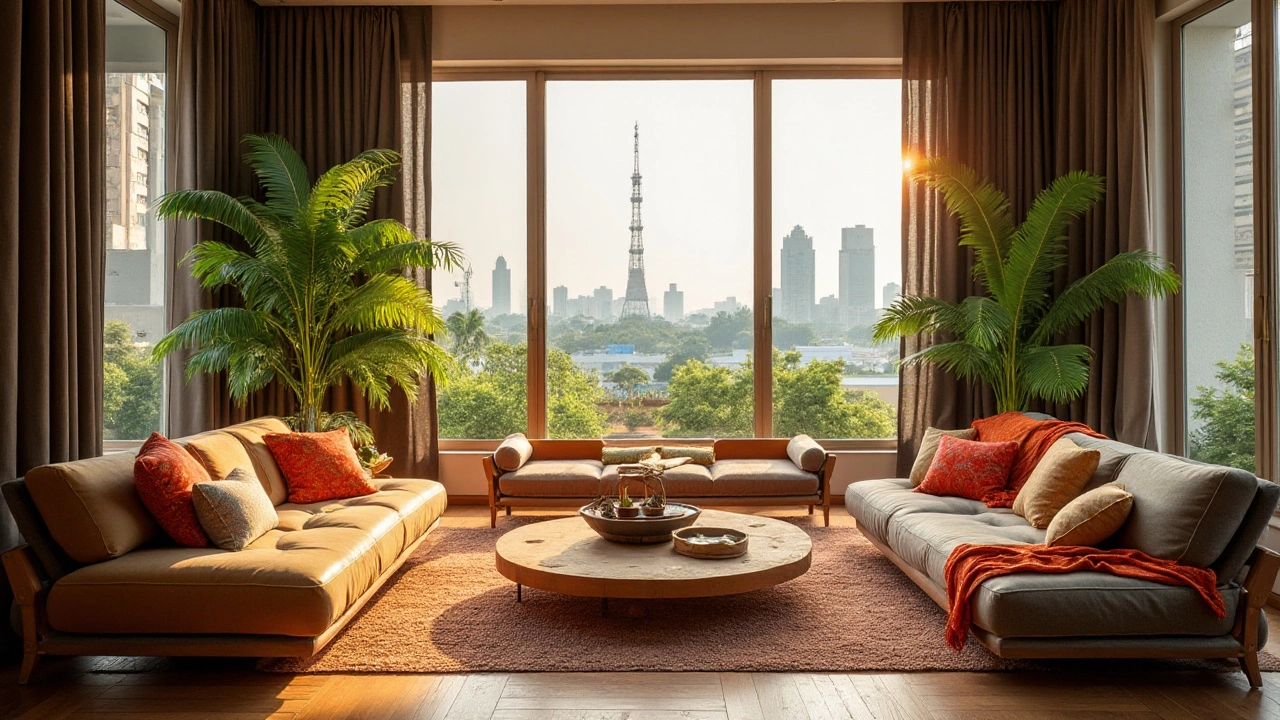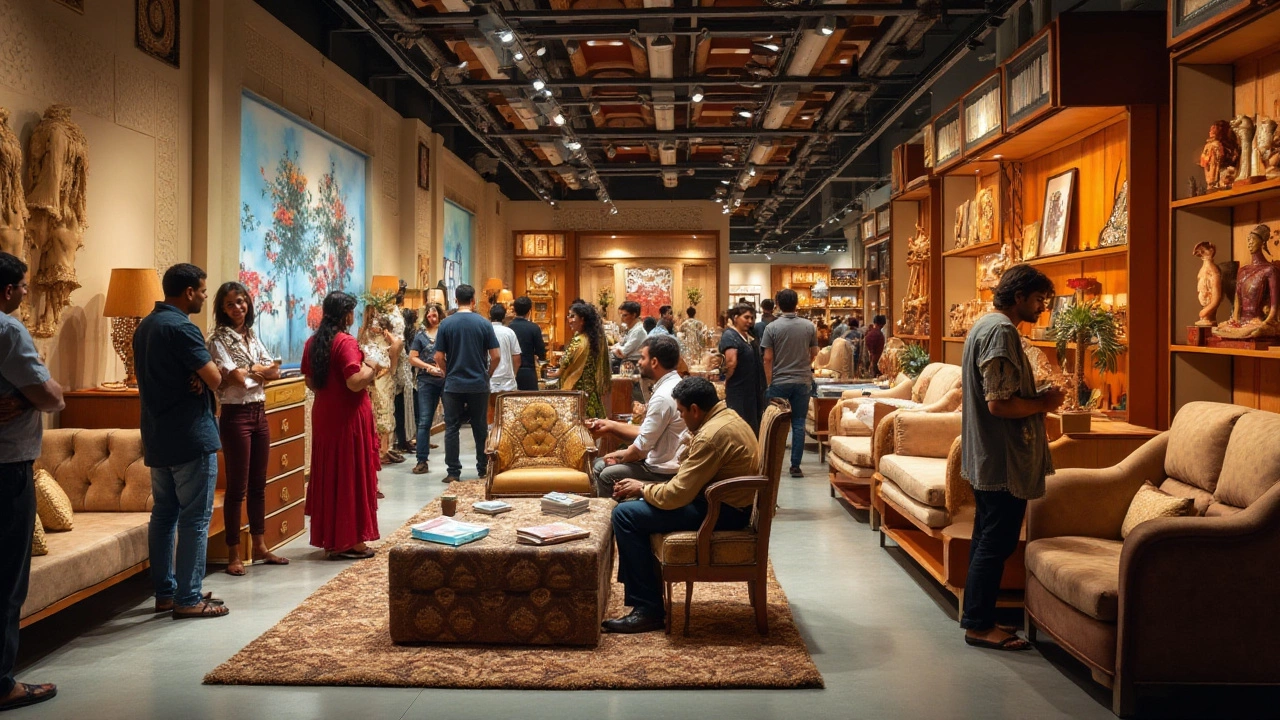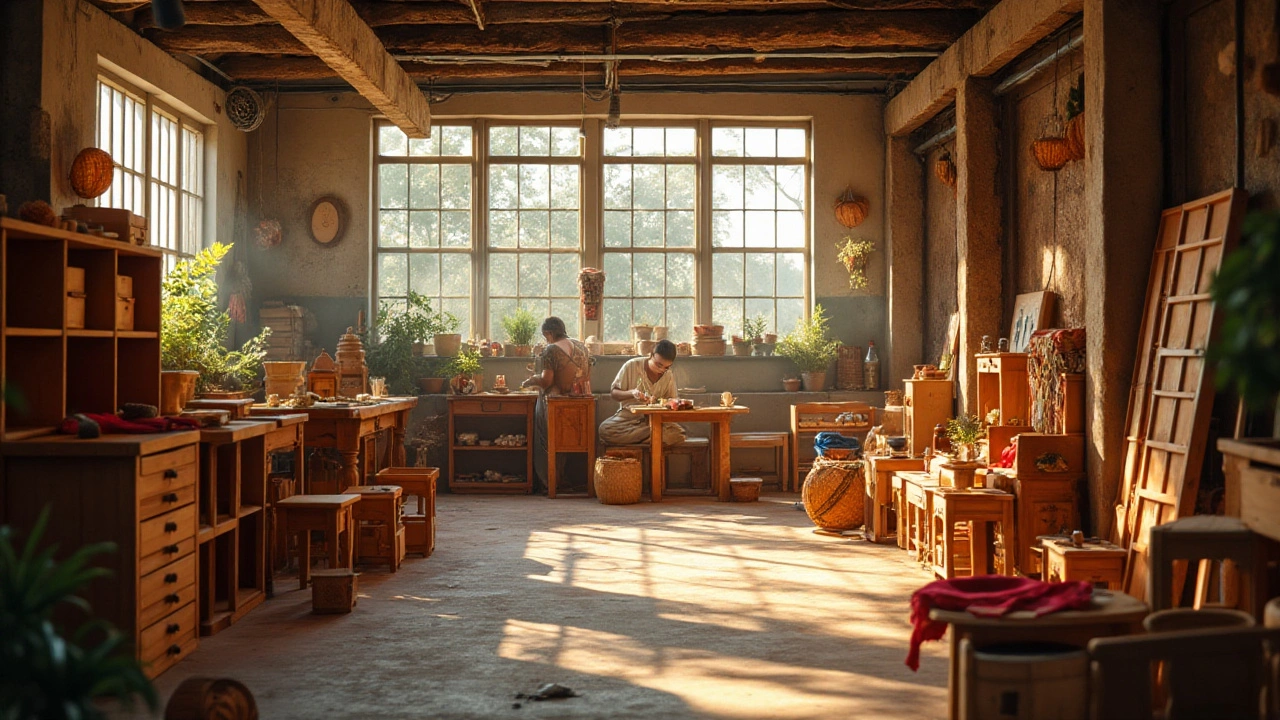The landscape of India's furniture manufacturing industry is undergoing a transformative phase. As one of the fastest-growing sectors, it reflects the country's burgeoning urbanization and evolving consumer preferences. People today are keen on stylish yet functional pieces that cater to smaller city apartments and expansive suburban villas alike.
Real estate expansion isn't just an urban dream anymore; it's a tangible transformation spreading across tier-two and tier-three cities. As spaces evolve, so does the need for innovative furniture solutions to suit varied living conditions and styles.
Designers and manufacturers in India are responding with an exciting mix of creativity and practicality, making the country a hub for both traditional craftsmanship and modern minimalism. This shift is not just about keeping up with global trends but also about nurturing local artistry and resources to cater to a diverse audience.
With an increasing emphasis on sustainability, manufacturers are turning to eco-friendly materials, reducing waste, and implementing efficient production processes. These factors make Indian furniture a fascinating sector to watch, promising growth and opportunities both domestically and internationally.
- Current Trends in Indian Furniture Manufacturing
- Impact of Urbanization on Furniture Demand
- Adoption of Innovative Designs and Materials
- Challenges and Opportunities for Manufacturers
- The Role of Sustainability in the Industry
Current Trends in Indian Furniture Manufacturing
Walking through the vibrant corridors of India's furniture industry, one finds a dynamic and evolving landscape fueled by diverse influences and consumer demands. Current trends reflect the interplay of modernity and tradition, with manufacturers striving to create products that resonate with both domestic and international markets. The steady rise in disposable income and urban living has led to increased consumer spending on home décor, positioning the furniture industry in India for significant growth. With a focus on innovation and versatility, manufacturers are catering to a wide array of styles, from chic urban setups to homes that exude traditional warmth.
The impact of globalization is evident as Indian furniture designers integrate global aesthetics with local materials and craftsmanship. There's a noticeable shift towards minimalistic and ergonomic designs, catering to the younger population's preference for functionality over ornate details. A growing appreciation for customized furniture solutions is also reshaping production processes. As households seek unique, personalized pieces, manufacturers are leveraging advanced technologies like CNC machines and 3D printing to meet these bespoke requirements promptly.
Renewable and sustainable practices are deeply embedded within current trends. Consumers are more conscious about the environmental impact of their purchases, prompting manufacturers to adopt eco-friendly processes and materials. Bamboo, rattan, and reclaimed wood are gaining popularity, reflecting a commitment to reducing carbon footprints. The Indian government's emphasis on sustainable development further catalyzes this movement, providing incentives and support for green manufacturing initiatives.
An undeniable influence is the rise of e-commerce platforms, which have transformed the buying process. Online portals provide customers with extensive choices, detailed descriptions, and customer reviews, breaking geographical barriers. This ease of access has encouraged furniture manufacturers to expand their online presence, ensuring greater visibility and market reach. The digital transformation also includes augmented reality tools that allow customers to visualize furniture in their space, enhancing purchasing decisions.
According to a report by the Federation of Indian Chambers of Commerce & Industry (FICCI), "The Indian furniture market is expected to grow at a CAGR of over 12% during the forecast period 2024-2029, driven by the rising middle-class population and rapid urbanization."
As the Indian manufacturing sector adapts to these contemporary demands, there are also efforts to address traditional issues such as logistical challenges and fragmented supply chains. Manufacturers are investing in advanced supply chain management systems to ensure efficient distribution and timely delivery, improving consumer satisfaction. This strategic focus, combined with the rich heritage of Indian craftsmanship, is setting the stage for the furniture manufacturing industry to thrive amidst global competition.
Impact of Urbanization on Furniture Demand
Urbanization's sweeping wave in India has left a marked influence on numerous economic sectors, with the furniture industry experiencing a notable transformation. As cities expand and populations grow, the demand for housing and its interior essentials has soared. This trend isn't just about increasing numbers of people moving into urban spaces but about how their lives and needs are changing. Space constraints, a common urban challenge, are redefining how furniture is perceived, designed, and utilized. Previously, large, ornate furniture pieces symbolized luxury, but today, compact, multifunctional units are much sought after.
The Ministry of Urban Development noted, "India will need to build 700 to 900 million square meters of residential and commercial space each year to keep up with urban population growth."
This shift in spatial planning forces furniture manufacturers to innovate. They are creating pieces that maximize utility without compromising style or comfort. For instance, foldable dining tables and convertible sofas allow residents to transform living rooms into party venues or cozy bedrooms seamlessly. Another fascinating development is the rise of smart furniture, incorporating technology to enhance user experiences. This trend aligns with the broader global movement towards smarter homes, where technology and furniture merge to create personalized living environments.
Beyond these changes, urban consumers today are more engaged with global design trends. As internet penetration deepens, young urbanites find themselves influenced by international aesthetics, which fuel the desire for diverse and chic furniture options. Consequently, Indian manufacturers are challenged and inspired to blend local craftsmanship with global designs. Additionally, cities like Bengaluru and Pune, previously overshadowed by larger metropolises, are now budding centers for real estate development. They are attracting young professionals who are eager to invest in contemporary and sophisticated home furnishings.
The urban middle class, experiencing rising incomes, plays a crucial role in this furniture demand surge. With more disposable income and an increasing penchant for home improvement, these consumers often refresh home interiors with modern furniture styles. This socio-economic group is particularly interested in eco-friendly products, which further shapes the manufacturing landscape. Understanding this, many companies have pivoted towards sustainable practices, offering furniture crafted from recycled materials or emphasizing environmentally responsible production methods.
Urbanization's ripple effects are also evident in how furniture is purchased. The convenience of digital platforms has made online furniture shopping equally, if not more, popular than traditional brick-and-mortar experiences. E-commerce giants and specialized online furniture stores are tapping into this digital trend, offering extensive catalogs and personalized services right at the fingertips of tech-savvy consumers. As a result, the entire shopping experience, from browsing to selection and even augmented reality-assisted trials, has reshaped consumer expectations and satisfaction.

Adoption of Innovative Designs and Materials
The evolution in India's furniture industry is marked by a significant embrace of innovation, driving both design and material usage. Manufacturers are acutely aware that today's consumers are searching for pieces that blend aesthetics with functionality. This demand has sparked a creative renaissance in the industry, triggering a wave of experimentation with new materials that are not only durable but also eco-friendly. For instance, there has been a noticeable shift towards the use of engineered wood, recycled materials, and even bamboo, which provide a sustainable alternative to traditional hardwoods without compromising on quality or style. Moreover, Indian designers are drawing inspiration from global trends while incorporating local artistry, creating unique and culturally rich designs that appeal to a diverse market.
A key aspect of this innovation lies in the adoption of technology within the manufacturing process. The integration of computer-aided design (CAD) systems has revolutionized how furniture pieces are conceptualized and produced. These tools enable designers to visualize complex geometric structures and make adjustments in real-time, ensuring precision and efficiency. This technological leap doesn't just streamline production; it also allows for greater customization options, giving consumers the freedom to tailor pieces to fit their unique tastes and spatial needs. As a result, bespoke furniture solutions are becoming increasingly popular, meeting the varied demands of both urban dwellers and those in suburban or rural areas.
Another exciting trend is the incorporation of smart technology into furniture design. With the rise of smart homes, the Indian furniture market is gradually incorporating intelligent features into their products. This includes tables with built-in wireless charging, couches with integrated sound systems, and beds with adjustable settings for optimal comfort. These advancements not only cater to tech-savvy consumers but also enhance the utility and appeal of the furniture itself.
"The future of furniture lies in adaptability and sustainability," said a representative from the All India Furniture Manufacturers Association. "As designers, we are constantly challenged to innovate while staying true to our cultural roots."
The materials used in furniture manufacturing also play a crucial role in the sector's evolution. There has been a conscious move towards using materials that are not only sustainable but also locally sourced, to reduce environmental impact and support local economies. For example, jute and coir are gaining popularity due to their biodegradability and abundance in India. Furthermore, furniture designed with minimalist principles using metal and glass combinations are on the rise, providing sleek and modern alternatives to more traditional designs.
The focus on innovation extends to the distribution and marketing of these products as well. E-commerce platforms have reshaped how furniture is sold, offering virtual showrooms and augmented reality experiences that allow customers to visualize how a piece might fit into their home. This has expanded the reach of the furniture industry in India, enabling manufacturers to tap into global markets with ease. Such technological adaptations are crucial in an age where digital interactions play an integral role in consumer decision-making processes. This dynamic blend of innovation in both product design and distribution channels is setting the stage for significant growth and success in the sector, making it an industry to watch closely in the coming years.
Challenges and Opportunities for Manufacturers
The furniture industry in India stands at a crossroads, where the allure of significant growth meets an array of challenges. One of the prime challenges is the stiff competition from the influx of imported furniture, which often appeals to the cost-conscious consumer due to its affordability. Indian manufacturers must navigate the balance between offering competitive pricing and maintaining quality and brand identity. Additionally, the fragmented nature of the industry remains a concern, with many small-scale units struggling to scale operations effectively. The sector needs to embrace consolidation and modernization to enhance productivity and quality control aspects.
On the flip side, there are ample opportunities for Indian manufacturers to capitalize on the growing demand for customized and locally inspired designs. This trend is providing a platform for local artisans to showcase Indian craftsmanship and artistry, catering to both domestic taste and international curiosity. Furthermore, the rise in e-commerce offers vast potential for expanding market reach, allowing manufacturers to tap into wider audiences than ever before. Developing a robust online presence and an efficient delivery model is becoming essential for success. Technology adoption, particularly in the realms of automation and innovative design software, is another opportunity, enhancing efficiency and design capabilities.
“India has the potential to become a global design hub by leveraging its innate artistry and modern manufacturing capabilities,” says renowned industry analyst Rajiv Suri.
Sustainability presents both a challenge and opportunity. Increasing consumer awareness and regulatory pressures mean that adhering to environmentally friendly practices is more critical than ever. This push encourages manufacturers to explore sustainable materials and processes, thereby appealing to eco-conscious consumers. Investing in research and development to discover new materials and improve energy efficiency is becoming crucial. Moreover, the government’s encouragement of initiatives like ‘Make in India’ provides incentives but also demands adherence to quality and compliance standards.
Collaborations with international brands and an emphasis on establishing a global footprint can also drive growth. Joint ventures can provide access to advanced technical know-how and design innovations, aiding in producing world-class furniture in India. However, to sustainably seize these opportunities, manufacturers need to focus on building a skilled workforce and fostering skill development. This requires commitment from both government and educational institutions to provide effective training programs. As the country’s middle-class continues to expand, the taste and requirement for luxurious and quality home furniture will rise, providing manufacturers a golden opportunity to establish themselves as leaders in the global market.

The Role of Sustainability in the Industry
In today’s environmentally-conscious world, the furniture industry in India is increasingly leaning towards sustainability, reflecting a blend of traditional practices with modern eco-friendly innovations. Consumers have become more aware of their carbon footprint, and this demand for sustainable products is changing how manufacturers operate. The shift involves not just sourcing raw materials responsibly but also rethinking processes and products from inception to finish. Given the vast landscape and resource diversity of India, companies have a multitude of options at their fingertips.
Manufacturers are embracing materials like bamboo and reclaimed wood, which align with ecological responsibility and local craftsmanship. Bamboo, known for its rapid growth and resilience, offers an excellent alternative to traditional timber, highlighting its dual role in sustainability and economic efficiency. Reclaimed wood, often salvaged from older structures, not only saves forests but adds a unique aesthetic narrative to furniture pieces—a testament that beauty doesn't have to come at environmental costs.
"The direction towards sustainability is not just a trend; it’s a necessity," noted Anupam Singh, an industry expert. "Consumers want to know where their products come from and what impact their purchase has on the world."
Producing furniture sustainably extends beyond materials. It includes efficient production processes that minimize waste and reduce energy consumption. Waste reduction can involve recycling scraps or using by-products for crafting smaller items, ensuring a zero-waste approach. Indian manufacturing facilities are gradually incorporating solar energy and wastewater treatment plants to not only cut operational costs but also adhere to global environmental standards.
Interestingly, the move towards sustainable practices opens avenues for innovative design approaches. Designers are experimenting with multi-functional pieces that suit diverse urban living spaces, melding aesthetics with utility. Nevertheless, challenges persist, like balancing cost and consumer expectations. Eco-friendly materials sometimes come with a price tag, yet the long-term savings on environmental resources are undeniable.
Sustainability in the furniture sector isn't merely a buzzword but a requisite journey for an evolving market. A focus on this not only enhances brand reputation but potentially opens new markets keen on environmentally responsible products. The road to a greener industry might be complex, but the innovation and dedication it inspires hold promise for the future. The rise of these growth sectors in India exemplifies a global shift towards sustainable practices, making India's contribution both significant and impactful.
